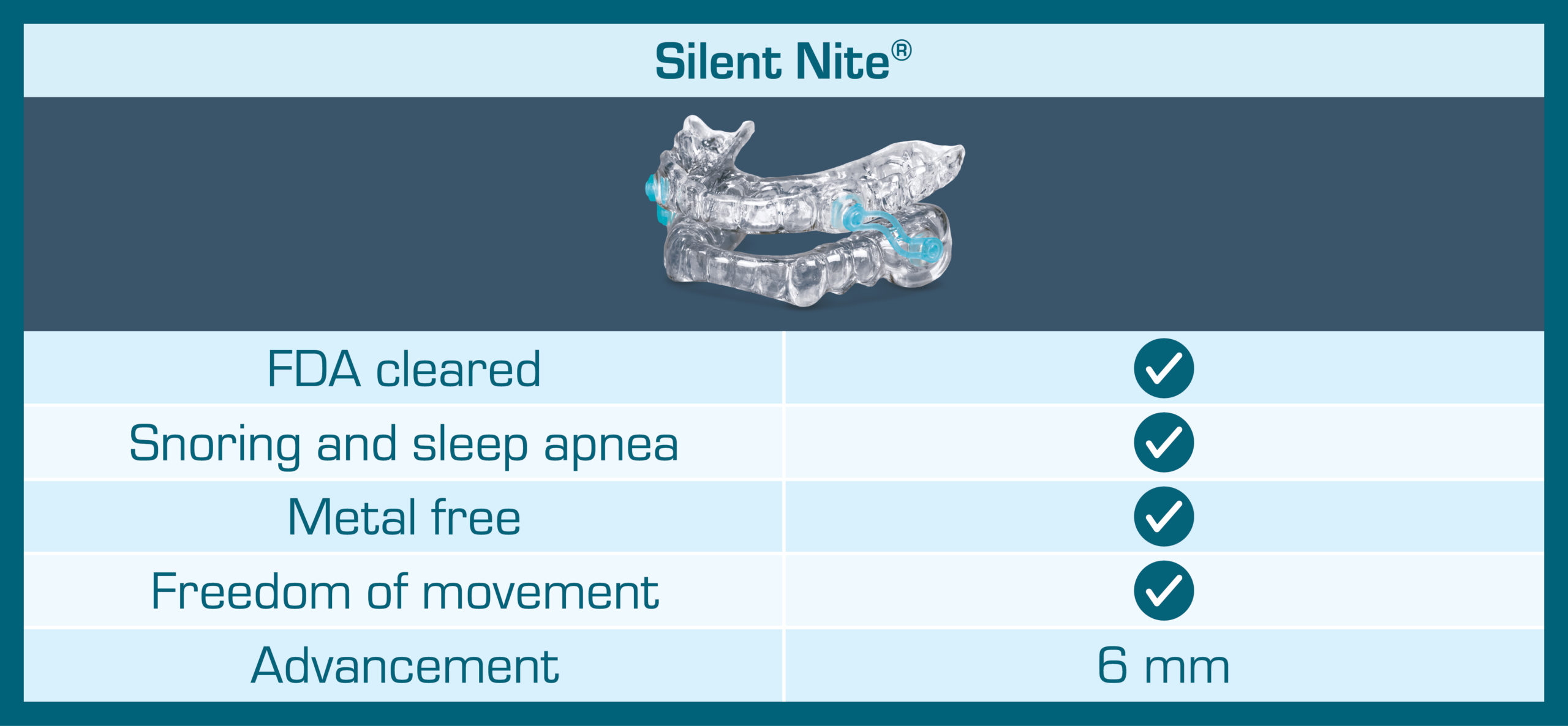Want to build your practice with sleep therapy, but don’t know where to begin? According to a recent poll published in Dentaltown, 57% of dentists believe the dental profession is not doing enough to address sleep apnea in the dental office — and only 30% of practices are screening for this condition. Per the American Dental Association (ADA), dentists are encouraged to screen patients for sleep-related breathing disorders (SRBDs) as part of a comprehensive medical and dental history. Screening involves recognizing symptoms — such as daytime sleepiness, choking, snoring or witnessed apneas — and an evaluation for risk factors, such as obesity, retrognathia or hypertension. If risk for SRBDs is determined, these patients should be referred, as needed, to the appropriate physicians for proper diagnosis.
Screening is the first step in building your practice with sleep therapy — and you can set yourself apart by incorporating this service into your practice.
Dental Treatment for Snoring and Sleep Apnea: Where to Begin?
Dentists have a tried-and-true solution for snoring and sleep apnea called mandibular advancement device (MAD) therapy — and the Silent Nite® Sleep Appliance, which has been in clinical use for more than 25 years, is a great place to start. With its straightforward treatment protocol, low cost, and clinical success in treating snoring and mild to moderate obstructive sleep apnea (OSA), the Silent Nite appliance helps you build your practice.
Features of the Silent Nite
Helping patients achieve a deeper, more satisfying night’s sleep, the Silent Nite appliance is flexible, thin and comfortable for patients to wear throughout the night. The appliance is designed to gently shift the lower jaw forward in a therapeutic position during sleep, which activates the airway muscles and ligaments to prevent the airway from collapsing. Each Silent Nite case includes extra connectors in various sizes and an AM Aligner to aid patients in exercising and realigning the jaw after nighttime mandibular advancement. Using the AM Aligner every morning helps to prevent bite change and tooth movement.

How to Treat Patients Using the Simplified Protocol
1. Screen Patients
SRBDs are characterized by disruptions in normal breathing patterns. They are potentially serious medical conditions caused by anatomical airway collapse and altered respiratory control mechanisms. Common SRBDs include snoring and OSA.
To screen patients for SRBDs, a simple two-part question can be used to identify patients who may be at risk. First, ask your patient: “Do you snore?” If the answer is yes, follow with: “Would you like to stop?” This can easily become part of the everyday patient screening process, undertaken at routine checkups and hygiene appointments. In addition, the STOP-BANG Questionnaire can be used as a reliable tool for predicting risk for OSA.
Nearly 50% of patients say they snore, and as many as 70% of patients who seek treatment for snoring and sleep apnea cite bed partner disturbance as the primary motivating factor.1 When patients are identified with a positive screen, the Silent Nite appliance — a popular anti-snoring device — may be provided provisionally to address the patient’s primary complaint: snoring.
2. Discuss Snoring and Sleep Apnea
Snoring and sleep apnea are related conditions that require a trained physician to discern the difference and manage the ongoing care for the subset of patients who suffer from OSA. For a dentist to treat snoring and sleep apnea provisionally, an informed consent document should be a part of the patient’s record. This requires a discussion about the relationship between snoring and sleep apnea. It also requires a referral to a sleep physician for diagnosis and medical management. Many dental offices take the additional step of sending a letter to the patient’s primary care physician to document that snoring treatment has begun in the dental office.
3. Initiate Provisional Treatment
After selecting the Silent Nite appliance, all that’s needed is upper and lower impressions and a bite registration. If a protrusion gauge is not available, an edge-to-edge position is recommended. To guide patients, you can say, “Bite the edges of your front teeth together like you’re biting thread.” Almost everybody can find that position, and that position almost never puts strain on the jaw. Submit the impressions and bite registration, along with your Rx form, to New West Dental Lab, and allow five working days in the lab.

Life Changing for Patients, a Practice Builder for You
Sleep-disordered breathing is associated with major morbidity and mortality. Patients with untreated sleep-disordered breathing are at increased risk of hypertension, stroke, heart failure, diabetes, car accidents and depression. Delivering the Silent Nite appliance is straightforward, and it can be titrated to provide a comfortable position that minimizes symptoms until a definitive diagnosis and permanent treatment can be determined. Depending on the needs of the patient, the Silent Nite appliance may then continue to be used for long-term care.

Success in sleep dentistry can be achieved by building case volume with an effective, affordable appliance that patients can use every night. New West helps dentists by offering the Silent Nite Sleep Appliance for only $157, an economical price point for any dental practice. And because New West provides fast a turnaround time (only five days in the lab), dentists can provide relief quickly.
To read more about the Silent Nite appliance, and to explore the New West family of mandibular advancement devices, visit newwestlab.com/sleep.
References
- 2016 Frost & Sullivan survey of 506 U.S. residents treating their OSA.




